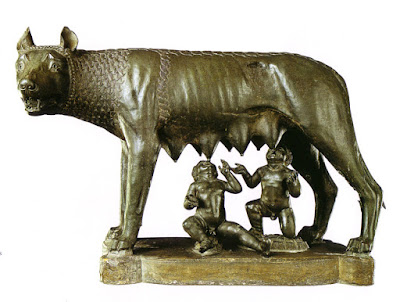Classical myth has it that the founder of Rome and his twin brother—Romulus
For better or worse, there’s no bronze statue commemorating this family myth. But when I’m stirring a pot of milk on the stove, I sometimes think I can see glimpses of it as the ricotta curds separate from the whey. Lacking the barn full of milk-heavy goats, I make do with the pasteurized stuff I can find at the grocery store. Pittsburgh
Ricotta hasn't been often counted among the sexier cheeses, but, at least according to this New York Times article, it's slowly becoming a "big cheese." That means it's no longer simply a ravioli filler or the mortar of lasagna layers. But I don't need swanky restaurant menus to convince me that fresh ricotta cheese deserves more. If you have any doubt, this recipe for crostini with ricotta and chorizo will set you straight. Seriously, this is one of the best things I've ever eaten.
Ricotta hasn't been often counted among the sexier cheeses, but, at least according to this New York Times article, it's slowly becoming a "big cheese." That means it's no longer simply a ravioli filler or the mortar of lasagna layers. But I don't need swanky restaurant menus to convince me that fresh ricotta cheese deserves more. If you have any doubt, this recipe for crostini with ricotta and chorizo will set you straight. Seriously, this is one of the best things I've ever eaten.
Makes about 2 cups. Can be doubled.
Adapted from Julian Moskin's New York Times article (May 28th, 2008), which was adapted from Michael Chiarello’s Casual Cooking.

This process really couldn't be much easier. The hardest part is finding the cheesecloth. Just make sure not to substitute low fat or skim milk for the full-fat stuff. You’ll end up with something white and creamy, and it will taste pretty good, but it won’t be ricotta cheese.
2 quarts whole milk
2 cups buttermilk
1. Line a wide colander with cheesecloth, folded so that it is at least 4 layers thick. Place colander in sink.
2. Pour milk and buttermilk into a heavy-bottomed pot. Cook over high heat, stirring frequently. Scrape the bottom of the pot occasionally to prevent scorching. As the milk heats, curds will begin to rise and clump on surface. Once mixture is steaming hot, stop stirring.
3.When mixture reaches 175 to 180 degrees on a candy thermometer, curds and whey will separate. (Whey will look like cloudy gray water underneath a mass of thick white curds.) Immediately turn off heat and gently ladle curds into sieve.
4.When all curds are in sieve and dripping has slowed (about 5 minutes), gently gather edges of cloth and twist to bring curds together; do not squeeze. Let drain 15 minutes more. Discard the whey.
5. Untie cloth and pack ricotta into an airtight container. Refrigerate and use within one week.



0 comments:
Post a Comment